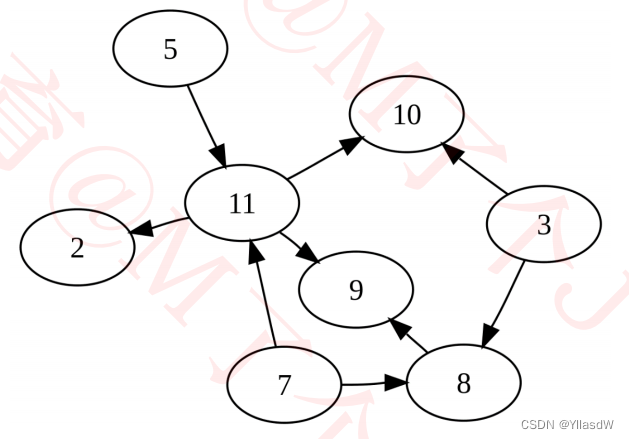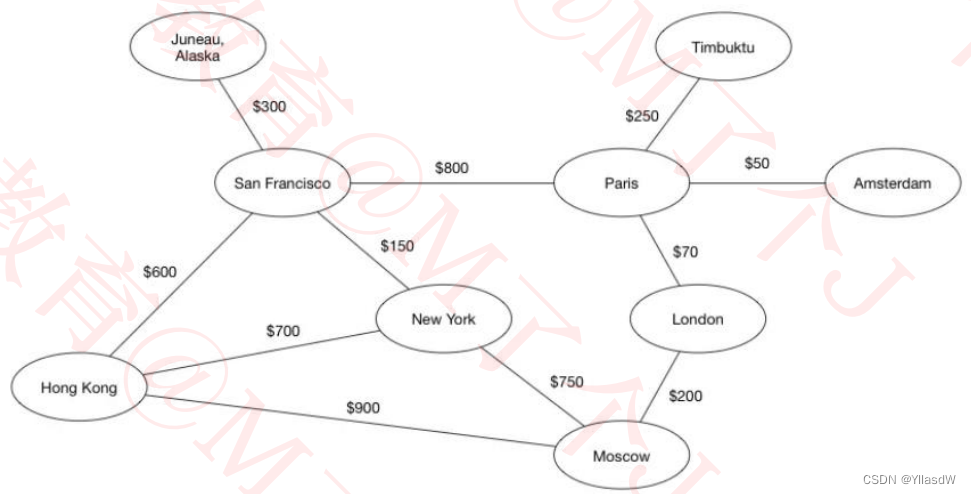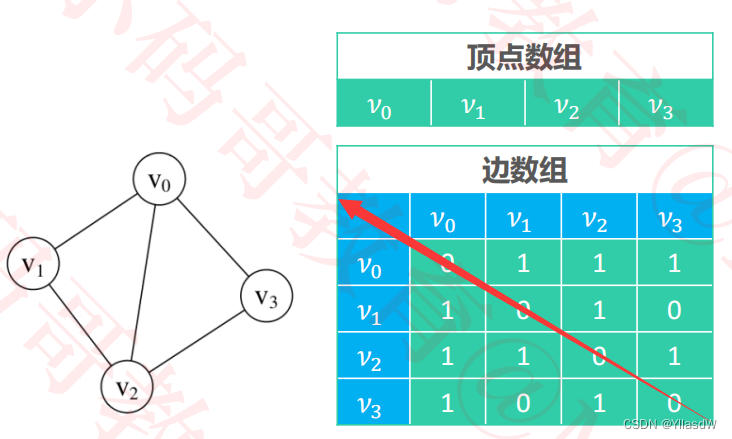图(Graph)
◼
图由
顶点
(vertex)和
边
(edge)组成,通常表示为 G = (V, E)
G表示一个图,V是顶点集,E是边集
顶点集V有穷且非空
任意两个顶点之间都可以用边来表示它们之间的关系,边集E可以是空的


有向图(Directed Graph)
有向图的边是有明确方向的

有向无环图(Directed Acyclic Graph,简称 DAG)
如果一个有向图,从任意顶点出发无法经过若干条边回到该顶点,那么它就是一个有向无环图

出度、入度
◼
出度(Out-degree)
一个顶点的出度为 x,是指有 x 条边以该顶点为起点
顶点11的出度是3
◼
入度(In-degree)
一个顶点的入度为 x,是指有 x 条边以该顶点为终点
顶点11的入度是2


无向图(Undirected Graph)
混合图(Mixed Graph)

简单图、多重图
◼
平行边
在无向图中,关联一对顶点的无向边如果多于1条,则称这些边为平行边
在有向图中,关联一对顶点的有向边如果多于1条,并且它们的的方向相同,则称这些边为平行边
◼
多重图(Multigraph)
有平行边或者有自环的图
◼
简单图(Simple Graph)
既没有平行边也不没有自环的图
课程中讨论的基本都是简单图


无向完全图
◼
无向完全图的任意两个顶点之间都存在边
n
个顶点的无向完全图有
n(n − 1)/2
条边
✓
n − 1 + n − 2 + n − 3 + ⋯ + 3 + 2 + 1

有向完全图(Directed Complete Graph)
◼
有向完全图的任意两个顶点之间都存在方向相反的两条边
n
个顶点的有向完全图有 n(n − 1) 条边

◼
稠密图(Dense Graph):边数接近于或等于完全图
◼
稀疏图(Sparse Graph):边数远远少于完全图
有权图(Weighted Graph)
有权图的边可以拥有权值(Weight)

连通图(Connected Graph)
如果顶点 x 和 y 之间存在可相互抵达的路径(直接或间接的路径),则称 x 和 y 是连通的

连通分量(Connected Component)
◼
连通分量:无向图的极大连通子图
连通图只有一个连通分量,即其自身;非连通的无向图有多个连通分量
◼
下面的无向图有3个连通分量

强连通图(Strongly Connected Graph)
如果有向图 G 中任意2个顶点都是连通的,则称G为强连通图

强连通分量(Strongly Connected Component)
◼
强连通分量:有向图的极大强连通子图
强连通图只有一个强连通分量,即其自身;非强连通的有向图有多个强连通分量

上面的图了解,过一遍就是可以的,去干饭干饭.
图的实现方案
◼
图有2种常见的实现方案
邻接矩阵(Adjacency Matrix)
邻接表(Adjacency List)
邻接矩阵(Adjacency Matrix)
◼
邻接矩阵的存储方式
一维数组存放顶点信息
二维数组存放边信息
◼
邻接矩阵比较适合稠密图
不然会比较浪费内存


 通过上面的图可以知道,它是关于对角线对称的.
通过上面的图可以知道,它是关于对角线对称的.
邻接矩阵 – 有权图


邻接表(Adjacency List)



邻接表 – 有权图

上面的概念真是乱的很,下面开始写代码了.
抽象类:
package com.mj.graph;
import java.util.LinkedList;
import java.util.List;
import java.util.Map;
import java.util.Set;
public abstract class Graph<V, E> {
protected WeightManager<E> weightManager;
public Graph() {}
public Graph(WeightManager<E> weightManager) {
this.weightManager = weightManager;
}
public abstract int edgesSize();
public abstract int verticesSize();
public abstract void addVertex(V v);//顶点
public abstract void addEdge(V from, V to);//边
public abstract void addEdge(V from, V to, E weight);//权重
public abstract void removeVertex(V v);
public abstract void removeEdge(V from, V to);
public abstract void bfs(V begin, VertexVisitor<V> visitor);
public abstract void dfs(V begin, VertexVisitor<V> visitor);
public abstract Set<EdgeInfo<V, E>> mst();
public abstract List<V> topologicalSort();
// public abstract Map<V, E> shortestPath(V begin);
public abstract Map<V, PathInfo<V, E>> shortestPath(V begin);
public abstract Map<V, Map<V, PathInfo<V, E>>> shortestPath();
public interface WeightManager<E> {
int compare(E w1, E w2);
E add(E w1, E w2);
E zero();
}
public interface VertexVisitor<V> {
boolean visit(V v);
}
public static class PathInfo<V, E> {
protected E weight;
protected List<EdgeInfo<V, E>> edgeInfos = new LinkedList<>();
public PathInfo() {}
public PathInfo(E weight) {
this.weight = weight;
}
public E getWeight() {
return weight;
}
public void setWeight(E weight) {
this.weight = weight;
}
public List<EdgeInfo<V, E>> getEdgeInfos() {
return edgeInfos;
}
public void setEdgeInfos(List<EdgeInfo<V, E>> edgeInfos) {
this.edgeInfos = edgeInfos;
}
@Override
public String toString() {
return "PathInfo [weight=" + weight + ", edgeInfos=" + edgeInfos + "]";
}
}
//定义的边
public static class EdgeInfo<V, E> {
private V from;//起始
private V to;//终止
private E weight;//权值
public EdgeInfo(V from, V to, E weight) {
this.from = from;
this.to = to;
this.weight = weight;
}
public V getFrom() {
return from;
}
public void setFrom(V from) {
this.from = from;
}
public V getTo() {
return to;
}
public void setTo(V to) {
this.to = to;
}
public E getWeight() {
return weight;
}
public void setWeight(E weight) {
this.weight = weight;
}
@Override
public String toString() {
return "EdgeInfo [from=" + from + ", to=" + to + ", weight=" + weight + "]";
}
}
}
实现类:
package com.mj.graph;
import java.util.ArrayList;
import java.util.Comparator;
import java.util.HashMap;
import java.util.HashSet;
import java.util.Iterator;
import java.util.LinkedList;
import java.util.List;
import java.util.Map;
import java.util.Map.Entry;
import java.util.Objects;
import java.util.Queue;
import java.util.Set;
import java.util.Stack;
import com.mj.MinHeap;
import com.mj.UnionFind;
@SuppressWarnings("unchecked")
public class ListGraph<V, E> extends Graph<V, E> {
public ListGraph() {}
public ListGraph(WeightManager<E> weightManager) {
super(weightManager);
}
private static class Vertex<V, E> {
V value;
Set<Edge<V, E>> inEdges = new HashSet<>();
Set<Edge<V, E>> outEdges = new HashSet<>();
Vertex(V value) {
this.value = value;
}
@Override
public boolean equals(Object obj) {
return Objects.equals(value, ((Vertex<V, E>)obj).value);
}
@Override
public int hashCode() {
return value == null ? 0 : value.hashCode();
}
@Override
public String toString() {
return value == null ? "null" : value.toString();
}
}
private static class Edge<V, E> {
Vertex<V, E> from;
Vertex<V, E> to;
E weight;
Edge(Vertex<V, E> from, Vertex<V, E> to) {
this.from = from;
this.to = to;
}
EdgeInfo<V, E> info() {
return new EdgeInfo<>(from.value, to.value, weight);
}
@Override
public boolean equals(Object obj) {
Edge<V, E> edge = (Edge<V, E>) obj;
return Objects.equals(from, edge.from) && Objects.equals(to, edge.to);
}
@Override
public int hashCode() {
return from.hashCode() * 31 + to.hashCode();
}
@Override
public String toString() {
return "Edge [from=" + from + ", to=" + to + ", weight=" + weight + "]";
}
}
private Map<V, Vertex<V, E>> vertices = new HashMap<>();
private Set<Edge<V, E>> edges = new HashSet<>();
private Comparator<Edge<V, E>> edgeComparator = (Edge<V, E> e1, Edge<V, E> e2) -> {
return weightManager.compare(e1.weight, e2.weight);
};
public void print() {
System.out.println("[顶点]-------------------");
vertices.forEach((V v, Vertex<V, E> vertex) -> {
System.out.println(v);
System.out.println("out-----------");
System.out.println(vertex.outEdges);
System.out.println("in-----------");
System.out.println(vertex.inEdges);
});
System.out.println("[边]-------------------");
edges.forEach((Edge<V, E> edge) -> {
System.out.println(edge);
});
}
@Override
public int edgesSize() {
return edges.size();
}
@Override
public int verticesSize() {
return vertices.size();
}
@Override
public void addVertex(V v) {
if (vertices.containsKey(v)) return;
vertices.put(v, new Vertex<>(v));
}
@Override
public void addEdge(V from, V to) {
addEdge(from, to, null);
}
@Override
public void addEdge(V from, V to, E weight) {
Vertex<V, E> fromVertex = vertices.get(from);
if (fromVertex == null) {
fromVertex = new Vertex<>(from);
vertices.put(from, fromVertex);
}
Vertex<V, E> toVertex = vertices.get(to);
if (toVertex == null) {
toVertex = new Vertex<>(to);
vertices.put(to, toVertex);
}
Edge<V, E> edge = new Edge<>(fromVertex, toVertex);
edge.weight = weight;
if (fromVertex.outEdges.remove(edge)) {
toVertex.inEdges.remove(edge);
edges.remove(edge);
}
fromVertex.outEdges.add(edge);
toVertex.inEdges.add(edge);
edges.add(edge);
}
@Override
public void removeEdge(V from, V to) {
Vertex<V, E> fromVertex = vertices.get(from);
if (fromVertex == null) return;
Vertex<V, E> toVertex = vertices.get(to);
if (toVertex == null) return;
Edge<V, E> edge = new Edge<>(fromVertex, toVertex);
if (fromVertex.outEdges.remove(edge)) {
toVertex.inEdges.remove(edge);
edges.remove(edge);
}
}
@Override
public void removeVertex(V v) {
Vertex<V, E> vertex = vertices.remove(v);
if (vertex == null) return;
for (Iterator<Edge<V, E>> iterator = vertex.outEdges.iterator(); iterator.hasNext();) {
Edge<V, E> edge = iterator.next();
edge.to.inEdges.remove(edge);
// 将当前遍历到的元素edge从集合vertex.outEdges中删掉
iterator.remove();
edges.remove(edge);
}
for (Iterator<Edge<V, E>> iterator = vertex.inEdges.iterator(); iterator.hasNext();) {
Edge<V, E> edge = iterator.next();
edge.from.outEdges.remove(edge);
// 将当前遍历到的元素edge从集合vertex.inEdges中删掉
iterator.remove();
edges.remove(edge);
}
}
@Override
public void bfs(V begin, VertexVisitor<V> visitor) {
if (visitor == null) return;
Vertex<V, E> beginVertex = vertices.get(begin);
if (beginVertex == null) return;
Set<Vertex<V, E>> visitedVertices = new HashSet<>();
Queue<Vertex<V, E>> queue = new LinkedList<>();
queue.offer(beginVertex);
visitedVertices.add(beginVertex);
while (!queue.isEmpty()) {
Vertex<V, E> vertex = queue.poll();
if (visitor.visit(vertex.value)) return;
for (Edge<V, E> edge : vertex.outEdges) {
if (visitedVertices.contains(edge.to)) continue;
queue.offer(edge.to);
visitedVertices.add(edge.to);
}
}
}
@Override
public void dfs(V begin, VertexVisitor<V> visitor) {
if (visitor == null) return;
Vertex<V, E> beginVertex = vertices.get(begin);
if (beginVertex == null) return;
Set<Vertex<V, E>> visitedVertices = new HashSet<>();
Stack<Vertex<V, E>> stack = new Stack<>();
// 先访问起点
stack.push(beginVertex);
visitedVertices.add(beginVertex);
if (visitor.visit(begin)) return;
while (!stack.isEmpty()) {
Vertex<V, E> vertex = stack.pop();
for (Edge<V, E> edge : vertex.outEdges) {
if (visitedVertices.contains(edge.to)) continue;
stack.push(edge.from);
stack.push(edge.to);
visitedVertices.add(edge.to);
if (visitor.visit(edge.to.value)) return;
break;
}
}
}
@Override
public List<V> topologicalSort() {
List<V> list = new ArrayList<>();
Queue<Vertex<V, E>> queue = new LinkedList<>();
Map<Vertex<V, E>, Integer> ins = new HashMap<>();
// 初始化(将度为0的节点都放入队列)
vertices.forEach((V v, Vertex<V, E> vertex) -> {
int in = vertex.inEdges.size();
if (in == 0) {
queue.offer(vertex);
} else {
ins.put(vertex, in);
}
});
while (!queue.isEmpty()) {
Vertex<V, E> vertex = queue.poll();
// 放入返回结果中
list.add(vertex.value);
for (Edge<V, E> edge : vertex.outEdges) {
int toIn = ins.get(edge.to) - 1;
if (toIn == 0) {
queue.offer(edge.to);
} else {
ins.put(edge.to, toIn);
}
}
}
return list;
}
@Override
public Set<EdgeInfo<V, E>> mst() {
return Math.random() > 0.5 ? prim() : kruskal();
}
private Set<EdgeInfo<V, E>> prim() {
Iterator<Vertex<V, E>> it = vertices.values().iterator();
if (!it.hasNext()) return null;
Vertex<V, E> vertex = it.next();
Set<EdgeInfo<V, E>> edgeInfos = new HashSet<>();
Set<Vertex<V, E>> addedVertices = new HashSet<>();
addedVertices.add(vertex);
MinHeap<Edge<V, E>> heap = new MinHeap<>(vertex.outEdges, edgeComparator);
int verticesSize = vertices.size();
while (!heap.isEmpty() && addedVertices.size() < verticesSize) {
Edge<V, E> edge = heap.remove();
if (addedVertices.contains(edge.to)) continue;
edgeInfos.add(edge.info());
addedVertices.add(edge.to);
heap.addAll(edge.to.outEdges);
}
return edgeInfos;
}
private Set<EdgeInfo<V, E>> kruskal() {
int edgeSize = vertices.size() - 1;
if (edgeSize == -1) return null;
Set<EdgeInfo<V, E>> edgeInfos = new HashSet<>();
MinHeap<Edge<V, E>> heap = new MinHeap<>(edges, edgeComparator);
UnionFind<Vertex<V, E>> uf = new UnionFind<>();
vertices.forEach((V v, Vertex<V, E> vertex) -> {
uf.makeSet(vertex);
});
while (!heap.isEmpty() && edgeInfos.size() < edgeSize) {
Edge<V, E> edge = heap.remove();
if (uf.isSame(edge.from, edge.to)) continue;
edgeInfos.add(edge.info());
uf.union(edge.from, edge.to);
}
return edgeInfos;
}
// public Map<V, E> shortestPath(V begin) {
// Vertex<V, E> beginVertex = vertices.get(begin);
// if (beginVertex == null) return null;
//
// Map<V, E> selectedPaths = new HashMap<>();
// Map<Vertex<V, E>, E> paths = new HashMap<>();
// // 初始化paths
// for (Edge<V, E> edge : beginVertex.outEdges) {
// paths.put(edge.to, edge.weight);
// }
//
// while (!paths.isEmpty()) {
// Entry<Vertex<V, E>, E> minEntry = getMinPath(paths);
// // minVertex离开桌面
// Vertex<V, E> minVertex = minEntry.getKey();
// selectedPaths.put(minVertex.value, minEntry.getValue());
// paths.remove(minVertex);
// // 对它的minVertex的outEdges进行松弛操作
// for (Edge<V, E> edge : minVertex.outEdges) {
// // 如果edge.to已经离开桌面,就没必要进行松弛操作
// if (selectedPaths.containsKey(edge.to.value)) continue;
// // 新的可选择的最短路径:beginVertex到edge.from的最短路径 + edge.weight
// E newWeight = weightManager.add(minEntry.getValue(), edge.weight);
// // 以前的最短路径:beginVertex到edge.to的最短路径
// E oldWeight = paths.get(edge.to);
// if (oldWeight == null || weightManager.compare(newWeight, oldWeight) < 0) {
// paths.put(edge.to, newWeight);
// }
// }
// }
//
// selectedPaths.remove(begin);
// return selectedPaths;
// }
@Override
public Map<V, PathInfo<V, E>> shortestPath(V begin) {
return dijkstra(begin);
}
@SuppressWarnings("unused")
private Map<V, PathInfo<V, E>> bellmanFord(V begin) {
Vertex<V, E> beginVertex = vertices.get(begin);
if (beginVertex == null) return null;
Map<V, PathInfo<V, E>> selectedPaths = new HashMap<>();
selectedPaths.put(begin, new PathInfo<>(weightManager.zero()));
int count = vertices.size() - 1;
for (int i = 0; i < count; i++) { // v - 1 次
for (Edge<V, E> edge : edges) {
PathInfo<V, E> fromPath = selectedPaths.get(edge.from.value);
if (fromPath == null) continue;
relax(edge, fromPath, selectedPaths);
}
}
for (Edge<V, E> edge : edges) {
PathInfo<V, E> fromPath = selectedPaths.get(edge.from.value);
if (fromPath == null) continue;
if (relax(edge, fromPath, selectedPaths)) {
System.out.println("有负权环");
return null;
}
}
selectedPaths.remove(begin);
return selectedPaths;
}
/**
* 松弛
* @param edge 需要进行松弛的边
* @param fromPath edge的from的最短路径信息
* @param paths 存放着其他点(对于dijkstra来说,就是还没有离开桌面的点)的最短路径信息
*/
private boolean relax(Edge<V, E> edge, PathInfo<V, E> fromPath, Map<V, PathInfo<V, E>> paths) {
// 新的可选择的最短路径:beginVertex到edge.from的最短路径 + edge.weight
E newWeight = weightManager.add(fromPath.weight, edge.weight);
// 以前的最短路径:beginVertex到edge.to的最短路径
PathInfo<V, E> oldPath = paths.get(edge.to.value);
if (oldPath != null && weightManager.compare(newWeight, oldPath.weight) >= 0) return false;
if (oldPath == null) {
oldPath = new PathInfo<>();
paths.put(edge.to.value, oldPath);
} else {
oldPath.edgeInfos.clear();
}
oldPath.weight = newWeight;
oldPath.edgeInfos.addAll(fromPath.edgeInfos);
oldPath.edgeInfos.add(edge.info());
return true;
}
private Map<V, PathInfo<V, E>> dijkstra(V begin) {
Vertex<V, E> beginVertex = vertices.get(begin);
if (beginVertex == null) return null;
Map<V, PathInfo<V, E>> selectedPaths = new HashMap<>();
Map<Vertex<V, E>, PathInfo<V, E>> paths = new HashMap<>();
paths.put(beginVertex, new PathInfo<>(weightManager.zero()));
// 初始化paths
// for (Edge<V, E> edge : beginVertex.outEdges) {
// PathInfo<V, E> path = new PathInfo<>();
// path.weight = edge.weight;
// path.edgeInfos.add(edge.info());
// paths.put(edge.to, path);
// }
while (!paths.isEmpty()) {
Entry<Vertex<V, E>, PathInfo<V, E>> minEntry = getMinPath(paths);
// minVertex离开桌面
Vertex<V, E> minVertex = minEntry.getKey();
PathInfo<V, E> minPath = minEntry.getValue();
selectedPaths.put(minVertex.value, minPath);
paths.remove(minVertex);
// 对它的minVertex的outEdges进行松弛操作
for (Edge<V, E> edge : minVertex.outEdges) {
// 如果edge.to已经离开桌面,就没必要进行松弛操作
if (selectedPaths.containsKey(edge.to.value)) continue;
relaxForDijkstra(edge, minPath, paths);
}
}
selectedPaths.remove(begin);
return selectedPaths;
}
/**
* 松弛
* @param edge 需要进行松弛的边
* @param fromPath edge的from的最短路径信息
* @param paths 存放着其他点(对于dijkstra来说,就是还没有离开桌面的点)的最短路径信息
*/
private void relaxForDijkstra(Edge<V, E> edge, PathInfo<V, E> fromPath, Map<Vertex<V, E>, PathInfo<V, E>> paths) {
// 新的可选择的最短路径:beginVertex到edge.from的最短路径 + edge.weight
E newWeight = weightManager.add(fromPath.weight, edge.weight);
// 以前的最短路径:beginVertex到edge.to的最短路径
PathInfo<V, E> oldPath = paths.get(edge.to);
if (oldPath != null && weightManager.compare(newWeight, oldPath.weight) >= 0) return;
if (oldPath == null) {
oldPath = new PathInfo<>();
paths.put(edge.to, oldPath);
} else {
oldPath.edgeInfos.clear();
}
oldPath.weight = newWeight;
oldPath.edgeInfos.addAll(fromPath.edgeInfos);
oldPath.edgeInfos.add(edge.info());
}
/**
* 从paths中挑一个最小的路径出来
* @param paths
* @return
*/
private Entry<Vertex<V, E>, PathInfo<V, E>> getMinPath(Map<Vertex<V, E>, PathInfo<V, E>> paths) {
Iterator<Entry<Vertex<V, E>, PathInfo<V, E>>> it = paths.entrySet().iterator();
Entry<Vertex<V, E>, PathInfo<V, E>> minEntry = it.next();
while (it.hasNext()) {
Entry<Vertex<V, E>, PathInfo<V, E>> entry = it.next();
if (weightManager.compare(entry.getValue().weight, minEntry.getValue().weight) < 0) {
minEntry = entry;
}
}
return minEntry;
}
@Override
public Map<V, Map<V, PathInfo<V, E>>> shortestPath() {
Map<V, Map<V, PathInfo<V, E>>> paths = new HashMap<>();
// 初始化
for (Edge<V, E> edge : edges) {
Map<V, PathInfo<V, E>> map = paths.get(edge.from.value);
if (map == null) {
map = new HashMap<>();
paths.put(edge.from.value, map);
}
PathInfo<V, E> pathInfo = new PathInfo<>(edge.weight);
pathInfo.edgeInfos.add(edge.info());
map.put(edge.to.value, pathInfo);
}
vertices.forEach((V v2, Vertex<V, E> vertex2) -> {
vertices.forEach((V v1, Vertex<V, E> vertex1) -> {
vertices.forEach((V v3, Vertex<V, E> vertex3) -> {
if (v1.equals(v2) || v2.equals(v3) || v1.equals(v3)) return;
// v1 -> v2
PathInfo<V, E> path12 = getPathInfo(v1, v2, paths);
if (path12 == null) return;
// v2 -> v3
PathInfo<V, E> path23 = getPathInfo(v2, v3, paths);
if (path23 == null) return;
// v1 -> v3
PathInfo<V, E> path13 = getPathInfo(v1, v3, paths);
E newWeight = weightManager.add(path12.weight, path23.weight);
if (path13 != null && weightManager.compare(newWeight, path13.weight) >= 0) return;
if (path13 == null) {
path13 = new PathInfo<V, E>();
paths.get(v1).put(v3, path13);
} else {
path13.edgeInfos.clear();
}
path13.weight = newWeight;
path13.edgeInfos.addAll(path12.edgeInfos);
path13.edgeInfos.addAll(path23.edgeInfos);
});
});
});
return paths;
}
private PathInfo<V, E> getPathInfo(V from, V to, Map<V, Map<V, PathInfo<V, E>>> paths) {
Map<V, PathInfo<V, E>> map = paths.get(from);
return map == null ? null : map.get(to);
}
// @Override
// public void bfs(V begin) {
// Vertex<V, E> beginVertex = vertices.get(begin);
// if (beginVertex == null) return;
//
// Set<Vertex<V, E>> visitedVertices = new HashSet<>();
// Queue<Vertex<V, E>> queue = new LinkedList<>();
// queue.offer(beginVertex);
// visitedVertices.add(beginVertex);
//
// while (!queue.isEmpty()) {
// Vertex<V, E> vertex = queue.poll();
// System.out.println(vertex.value);
//
// for (Edge<V, E> edge : vertex.outEdges) {
// if (visitedVertices.contains(edge.to)) continue;
// queue.offer(edge.to);
// visitedVertices.add(edge.to);
// }
// }
// }
//
// @Override
// public void dfs(V begin) {
// Vertex<V, E> beginVertex = vertices.get(begin);
// if (beginVertex == null) return;
//
// Set<Vertex<V, E>> visitedVertices = new HashSet<>();
// Stack<Vertex<V, E>> stack = new Stack<>();
//
// // 先访问起点
// stack.push(beginVertex);
// visitedVertices.add(beginVertex);
// System.out.println(beginVertex.value);
//
// while (!stack.isEmpty()) {
// Vertex<V, E> vertex = stack.pop();
//
// for (Edge<V, E> edge : vertex.outEdges) {
// if (visitedVertices.contains(edge.to)) continue;
//
// stack.push(edge.from);
// stack.push(edge.to);
// visitedVertices.add(edge.to);
// System.out.println(edge.to.value);
//
// break;
// }
// }
// }
// public void dfs2(V begin) {
// Vertex<V, E> beginVertex = vertices.get(begin);
// if (beginVertex == null) return;
// dfs2(beginVertex, new HashSet<>());
// }
//
// private void dfs2(Vertex<V, E> vertex, Set<Vertex<V, E>> visitedVertices) {
// System.out.println(vertex.value);
// visitedVertices.add(vertex);
//
// for (Edge<V, E> edge : vertex.outEdges) {
// if (visitedVertices.contains(edge.to)) continue;
// dfs2(edge.to, visitedVertices);
// }
// }
}


























 1007
1007

 被折叠的 条评论
为什么被折叠?
被折叠的 条评论
为什么被折叠?








